Drosophila sosie functions with β(H)-Spectrin and actin organizers in cell migration, epithelial morphogenesis and cortical stability
- PMID: 23213377
- PMCID: PMC3507177
- DOI: 10.1242/bio.20122154
Drosophila sosie functions with β(H)-Spectrin and actin organizers in cell migration, epithelial morphogenesis and cortical stability
Abstract
Morphogenesis in multicellular organisms requires the careful coordination of cytoskeletal elements, dynamic regulation of cell adhesion and extensive cell migration. sosie (sie) is a novel gene required in various morphogenesis processes in Drosophila oogenesis. Lack of sie interferes with normal egg chamber packaging, maintenance of epithelial integrity and control of follicle cell migration, indicating that sie is involved in controlling epithelial integrity and cell migration. For these functions sie is required both in the germ line and in the soma. Consistent with this, Sosie localizes to plasma membranes in the germ line and in the somatic follicle cells and is predicted to present an EGF-like domain on the extracellular side. Two positively charged residues, C-terminal to the predicted transmembrane domain (on the cytoplasmic side), are required for normal plasma membrane localization of Sosie. Because sie also contributes to normal cortical localization of β(H)-Spectrin, it appears that cortical β(H)-Spectrin mediates some of the functions of sosie. sie also interacts with the genes coding for the actin organizers Filamin and Profilin and, in the absence of sie function, F-actin is less well organized and nurse cells frequently fuse.
Keywords: Cell migration; Cortical organization and stability; Drosophila oogenesis; Epithelia; Morphogenesis; Spectrin.
Conflict of interest statement
Figures
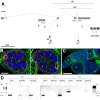
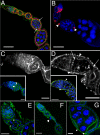

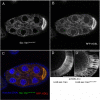
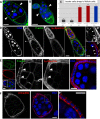

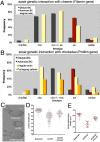
Similar articles
-
The serine/threonine kinase dPak is required for polarized assembly of F-actin bundles and apical-basal polarity in the Drosophila follicular epithelium.Dev Biol. 2007 May 15;305(2):470-82. doi: 10.1016/j.ydbio.2007.02.034. Epub 2007 Mar 2. Dev Biol. 2007. PMID: 17383630
-
Epithelial morphogenesis in the Drosophila egg chamber requires Parvin and ILK.Front Cell Dev Biol. 2022 Dec 1;10:951082. doi: 10.3389/fcell.2022.951082. eCollection 2022. Front Cell Dev Biol. 2022. PMID: 36531940 Free PMC article.
-
Role of Adducin-like (hu-li tai shao) mRNA and protein localization in regulating cytoskeletal structure and function during Drosophila Oogenesis and early embryogenesis.Dev Genet. 1996;19(3):249-57. doi: 10.1002/(SICI)1520-6408(1996)19:3<249::AID-DVG8>3.0.CO;2-9. Dev Genet. 1996. PMID: 8952067
-
Mass transit: epithelial morphogenesis in the Drosophila egg chamber.Dev Dyn. 2005 Mar;232(3):559-74. doi: 10.1002/dvdy.20286. Dev Dyn. 2005. PMID: 15704134 Review.
-
The repertoire of epithelial morphogenesis on display: Progressive elaboration of Drosophila egg structure.Mech Dev. 2017 Dec;148:18-39. doi: 10.1016/j.mod.2017.04.002. Epub 2017 Apr 19. Mech Dev. 2017. PMID: 28433748 Review.
Cited by
-
The role of spectrin in cell adhesion and cell-cell contact.Exp Biol Med (Maywood). 2019 Nov;244(15):1303-1312. doi: 10.1177/1535370219859003. Epub 2019 Jun 21. Exp Biol Med (Maywood). 2019. PMID: 31226892 Free PMC article. Review.
-
αII-spectrin and βII-spectrin do not affect TGFβ1-induced myofibroblast differentiation.Cell Tissue Res. 2018 Oct;374(1):165-175. doi: 10.1007/s00441-018-2842-x. Epub 2018 May 3. Cell Tissue Res. 2018. PMID: 29725768 Free PMC article.
-
A role for tuned levels of nucleosome remodeler subunit ACF1 during Drosophila oogenesis.Dev Biol. 2016 Mar 15;411(2):217-230. doi: 10.1016/j.ydbio.2016.01.039. Epub 2016 Feb 2. Dev Biol. 2016. PMID: 26851213 Free PMC article.
-
How do Wolbachia modify the Drosophila ovary? New evidences support the "titration-restitution" model for the mechanisms of Wolbachia-induced CI.BMC Genomics. 2019 Jul 24;20(1):608. doi: 10.1186/s12864-019-5977-6. BMC Genomics. 2019. PMID: 31340757 Free PMC article.
-
Data-driven networking of global transcriptomics and male sexual development in the main malaria vector, Anopheles funestus.Sci Rep. 2023 Oct 5;13(1):16798. doi: 10.1038/s41598-023-43914-0. Sci Rep. 2023. PMID: 37798302 Free PMC article.
References
-
- Brand A. H., Perrimon N. (1993). Targeted gene expression as a means of altering cell fates and generating dominant phenotypes. Development 118, 401–415. - PubMed
LinkOut - more resources
Full Text Sources
Molecular Biology Databases

